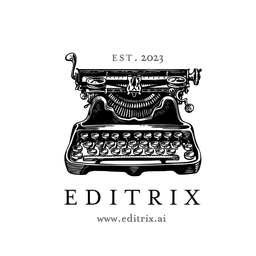How AI Editing Tools Are Quietly Transforming Small Publisher Workflows
For small publishers, the editorial process often feels like a juggling act: tight budgets, limited teams, and the expectation to deliver books that can stand shoulder to shoulder with titles from the largest houses. And in an industry where quality takes time, but time is a luxury, this creates an unavoidable bottleneck. Which is precisely where AI editing tools for publishers, like Editrix.ai, are beginning to shift the equation.
The Real Constraints of Small Publisher Workflow
At most small publishing houses, a handful of people do the work of many. The same editor might be acquiring manuscripts, managing authors, coordinating freelancers, copy editing, and proofreading; all while trying to keep an eye on sales and marketing. This inevitably leads to a few recurring problems:
Time strain: Every manuscript goes through several rounds of edits, often slowing down the path to publication.
Inconsistency: With fewer people on the team, it’s harder to maintain a clear house style across different titles.
Capacity limits: Without the budget for stage-specific editors, it’s tough to scale up without compromising on quality.
None of this is news to those working in independent publishing. But it does set the stage for understanding why AI-powered editing tools are becoming essential for editors, not as a replacement but as a way to make small teams more effective.
Where AI Editing Tools Fit In
Used well, AI editing tools like Editrix serve as a kind of second brain—taking on the routine work so human editors can focus on the parts of the job that require judgement, nuance, and experience.
1. They speed up the first pass
Most manuscripts need a first layer of clean-up: grammar and punctuation, structural oddities, repetition, tonal inconsistencies. Normally this takes days. With AI, it takes minutes. What you’re left with is a clearer draft that your editor can now engage with at a deeper level.
2. They improve consistency across titles
Maintaining a house style is hard when the team is small. AI editing tools allow you to set up customizable style guides and apply them automatically across manuscripts. The result is a more unified voice across your list—something readers notice, even if they can’t always articulate why.
3. They expand what you can take on
Perhaps the most pragmatic advantage: AI makes it possible to handle more books without adding headcount. Small publishers using Editrix have been able to increase the number of titles they publish annually without stretching their editors to breaking point. Quality doesn’t suffer; if anything, it improves, because the team has more bandwidth to focus on what really matters.
How to Integrate AI Editing Tools into Your Workflow
The best results come when AI is integrated deliberately as a partner, not as a replacement.
Step 1: Begin with the AI
Start with Editrix doing the first pass. It will highlight the obvious issues and surface a general editorial map: what’s working, what’s not, what needs attention.
Step 2: Let your editors go deep
With the groundwork laid, your team can now engage in real developmental editing—addiing their own insights to structure, market fit. The work that requires taste, insight, and instinct.
Step 3: Return to the AI for polish
Once major edits are done, bring the manuscript back to the tool. Use AI prompts tailored to your genre and house style to fine-tune line edits and formatting.
Step 4: Final human pass
Your editors close the loop. No longer bogged down in commas or formatting tweaks, they can focus on the manuscript as a whole: its emotional arc, its place in the list.
What Small Publishers Are Seeing
Small publishers who’ve adopted Editrix are reporting real, tangible outcomes:
Time spent on line edits and proofing has dropped by up to 60%
Editorial teams are comfortably taking on up more manuscripts
Style consistency has improved across genres and authors
Authors are happier—with faster timelines and sharper edits, but also, because the editors have more time for them
A Thoughtful Path Forward
AI-powered editing tools aren’t about replacing human editors. They’re about letting editors do the work only humans can do. Editrix was built precisely with this in mind. It’s not another generic grammar checker; it’s a tool shaped by the realities of small publisher workflow, editorial efficiency, and the standards that actually matter.
For publishers trying to keep up with the pace of change without losing their soul, AI editing tools aren’t a threat—they’re a chance to work smarter, not harder. And that’s a shift worth making.
